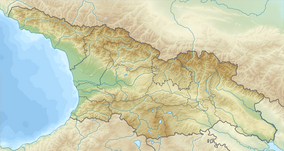Kolkheti National Park
| Kolkheti (mingrelia) National Park | |
|---|---|
 Pichori river in Kolkheti National Park | |
| Location | |
| Coordinates | 42°6′39″N 41°41′46″E / 42.11083°N 41.69611°E |
| Area | 807.99 km2 (311.97 sq mi)[1] |
| Established | 1998–1999 |
| Visitors | 13,747 (in 2015) |
| Governing body | Agency of Protected Areas |
| Website | Kolkheti National Park Administration |
| Official name | Wetlands of Central Kolkheti |
| Designated | 7 February 1997 |
| Reference no. | 893[2] |
Kolkheti National Park (
History
Ancient history of Kolkheti
Kolkheti National Park was once part of the tropical and partly subtropical zone of the
The advanced economy and favorable geographical and natural conditions of the area attracted the
The region became inhabited by a number of related but distinct tribes whose settlements lay chiefly along the shore of the Black Sea. Numbered amongst these were the
During the rule of the
Modern history and developments
In modern times, large-scale drainage undertaken by the
Local and international NGOs petitioned against the oil terminal and Green Alternative, a Georgian NGO, were particularly active in the protests but without initial success.[13] In the end, the construction of the Kulevi Terminal was abandoned in late 2002, reportedly because of financial reasons, but the marine area of the Kolkheti National Park still clashes with land permitted to oil and gas companies for oil exploitation, conflicting with the official designated protected area.[13]
Hydrology
Over half the park, 15,742 hectares, consists of wetlands.[11] Many small stagnant rivers including the Pichori River, Kukani River, Dedabera River, Tkhorina River, Tsia River, Tsiva River, Churia River, Munchia River, Mukhurjina River and other smaller streams flow through the park mainly through flat coastal plain at an average elevation of 0–10 metres.[11] A narrow dune ridge, some 100-200-meters-wide has developed along the Black Sea shore that rises some 2–3 m above the coastal plain.[11] Much of the land is peat bog and marsh,[14] some of which form several distinct peat bogs, including Anaklia, Churia, Nabada, Imnati, Maltakva, Grigoleti and Pichori which are located on the coastal plain.[11] In places peat layers may exceed 12 meters in thickness, the result of clay, sand, silt and peat deposits over the last 4000 to 6000 years.[11] In some areas the marsh is indunated completely with a number of lakes including Lake Paliastomi, Patara Paliastomi Lake, Imnati Lake and Parto Tskali Lake.[11]
Climate
The climate of Kolkheti National Park is warm and humid climate and annual rainfall ranges from 1500 to 1600 mm, relatively equal through the year. The park is subject to heavy periodical coastal winds and the coldest month, January can reach temperatures as low as 4.5 degrees Celsius. During the summer it is a moderate temperature, reaching 22 degrees Celsius in August on average.[11] However, in August, temperatures have been known to reach as high as 34 degrees Celsius.[15]
Wildlife
Flora
The climate of the park and abundance of water has resulted in a rich bioversity of flora in the coastal marshes and swamped forests and the deciduous wetland forest, is composed mostly of bearded

The coastal peat bogs are the home to many types of plants including
Fauna

The swamps and wetland forests of the park contain a number of endangered species such as
Tourism
Despite the protection of the park, the Georgian government has recently found a way to attract tourists whilst maintaining and protecting the natural habitat. The park was opened to tourists in 2007, attracting 1000 people in that year.[6] Boating tours, notably on Lake Paliastomi and on the Pichori River are offered, as are diving, bird watching, hiking and horse riding. There are several boating traits that range from 3 kilometers long to greater than 10 kilometers long.[6]
See also
- Rioni River
- Katsoburi Managed Reserve
- Kobuleti Managed Reserve
References
- ^ a b Kolkheti in Georgia Archived 2018-10-26 at the Wayback Machine Protected Planet
- ^ "Wetlands of Central Kolkheti". Ramsar Sites Information Service. Archived from the original on 2 April 2019. Retrieved 1 April 2019.
- ^ a b Wetlands of Central Kolkheti in Georgia Archived 2018-11-16 at the Wayback Machine Protected Planet
- ^ a b c "Sites to visit:Kolkheti National Park". Georgian Holidays. Archived from the original on April 26, 2013. Retrieved September 14, 2009.
- ^ "Colchic Rainforests and Wetlands". UNESCO World Heritage Centre. Retrieved 24 April 2022.
- ^ a b c d e Rekhviashvili, Anna (April 25, 2008). "Kolkheti National Park ready to welcome tourists". Georgian Daily. Archived from the original on January 2, 2010. Retrieved September 14, 2009.
- ^ a b c "Sister Parks". NPS. Retrieved September 27, 2009.
- ISBN 978-0-8160-7109-8.
- ^ "Abkhaz", in The Annual of the Society for the Study of Caucasia, 3, 13-18, Chicago, 1991
- ISBN 0-86054-700-0.)
{{cite book}}: CS1 maint: multiple names: authors list (link - ^ a b c d e f g h i j k l "Kolkheti National Park". Kolkheti National Park. Archived from the original on May 13, 2009. Retrieved September 27, 2009.
- ^ "Kolkheti National Park". Georgian holidays. Archived from the original on April 26, 2013. Retrieved September 27, 2009.
- ^ a b "Georgia Integrated Coastal Management Project: Kolkheti National Park". BICUSA. Archived from the original on October 6, 2006. Retrieved September 27, 2009.
- ISBN 92-64-18701-4. Archivedfrom the original on 19 December 2020. Retrieved 12 December 2020.
- ^ a b c d e f g "Wetlands of the western Georgia: Kolkheti national park". Caucasus Birding. Archived from the original on July 21, 2011. Retrieved September 27, 2009.
- ^ "Rhododendron flavum". Archived from the original on 2020-09-25. Retrieved 2018-11-08.


